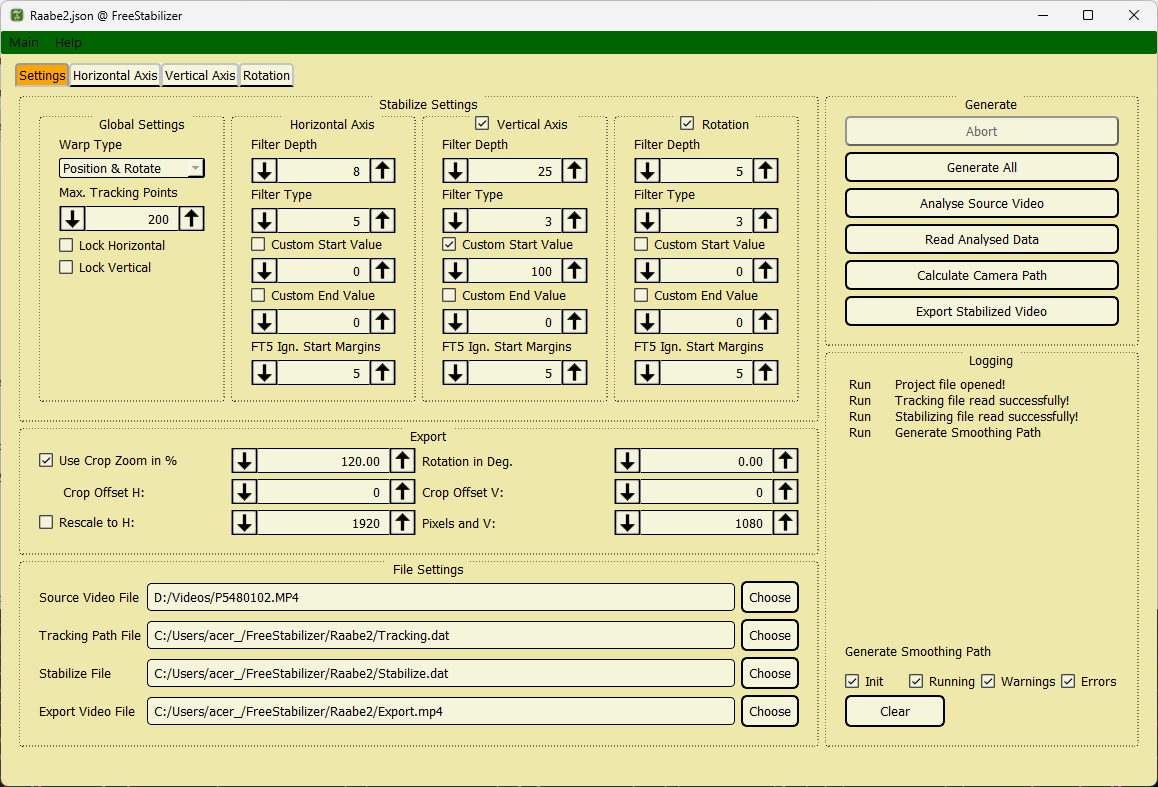The video stabilization program features a new operational concept where video stabilization occurs before the video cutting process, using a program of your choice.

V0.2 Windows
The camera flow is displayed graphically, including the camera flow filters and the distance between the image edges and the desired image section for each individual frame. This means you can quickly find the optimal filter setting for the video without having to watch the video or re-analyze it.
| V0.3: type 4 filtered camera flow |
|
V0.3: manually edited camera flow |
 |
|
 |
As a highlight starting with V0.3 parts of the stabilized video can be improved by manually overwriting camera path lines for the optimal stabilization result. Sections with low motion can be stabilized like a tripod shot and moving scences can be stabilized to look like smooth camera wagon clips! The good adaptive filters from V0.1 described in the next section cannot come nearly close this new approach.
| V0.1 Manjaro Linux: filter type 5 path |
|
V0.1 Manjaro Linux: filter type 5 margin |
| |
|
|
 |
|
 |
There are two adaptive filters to choose from, which in many videos increase the filter performance in quiet phases and weaken the filter performance in turbulent phases so that no image edges are visible in the desired image section during fast movements.
In the t5.json project you can see the use of adaptive filter type 5. From frame 2300 to frame 2700, the filter performance was massively increased. Before and after, the red line differs from the black line, which reduces the filter performance so that no black edges are visible in the crop (image section). If the black line falls below 0, it means that image edges can be seen in the exported video. The red line shows how much the strong filter would show the edges. Unfortunately, at around frame 1970 and around frame 2000, vertical edges can be seen in the exported video. From frame 2820 the video part is probably unusable.
The Version >= V0.2 now does provide a silent, fast and smooth Video Player where you can watch the stabilization result before exporting the video. On my PC a with an Intel 9400I CPU I was able to playback a on the fly smoothed 4K video up to 30 fps and FHD up tp 90 fps.
System Requirements
Average memory usage while stabilizing or exporting 2.5GB RAM
Windows 11: 8GB RAM, ca. 200MB hard disc space (without NVIDIA GPU-Accelleration)
Older Windows Versions: high likely yes, but untested!
Linux with Wine: Yes, but the fonts look mediocure.
Who wants to use this video stabilization program
- Wildlife filmmakers, sports filmmakers and anyone who shoots handheld with a telephoto lens.
- Anyone who is looking for a better alternative to the built-in stabilization of their favorite editing programs.
- Recovering of otherwise unusable video sequences.
- Anybody who wants better performance during video editing through prestabilized clips.
Limits
Unfortunately, version V0.4 cannot copy the audio track, the exported video is silent!
Professional Version
The stabilization with zoom, perspective and homography are not yet available in this version. These generally deliver worse results when recording videos with all stabilization programs of moving objects.
An advanced, paid Professional Version is currently in development, set to include the following features:
- Rolling shutter correction
- Exporting in an almost lossless format
- Variable zoom
- Lens correction
Donate
Special thanks to all my supporters which enabling me continuing this work!
You can donate for this topics
- FreeStabilizer Software
- European hamster research (Ultraschall records, how the communicate together)
- Youtube channel Travel and Nature
Download
Windows 11 & Wine 64 BIT
This version does not have an installer and can be executed in any extracted folder.
Manjaro Linux
The operating system must be up to date to use this software! After the download you can extract the tar archive and install the program in the download folder with the call
pamac install freestabilizer-pkgver.pkg.tar.zst
This should download automatically the missing software libraries. You can start the program tipping
FreeStabilizer in the terminal or the manjaro menu search.
For the Linux version it is allowed to adapt the application dependencies with the system calls patchelf + readelf to get FreeStabilizer running on your Linux operating system without any warranties. Following package dependencies are required: mkvtoolnix-cli openh264 qwt opencv qt5-base
Changelog
V0.4.1 First Linux version + bugfixes for Windows
V0.4 Improved Manual camera path editing, Bugfixes
V0.3 Excellent Manual camera flow path editing added.
V0.2 Preview player integration, improved start and endings, dark theme.
V0.1.1 Windows facelift version with a total custom style.
| Before |
|
After |
 |
|
 |
V0.1 Initial Version with native operating system styles, uses only 1.5GB RAM.
![]() (YouTube link)
(YouTube link)



 V0.2 Windows
V0.2 Windows





